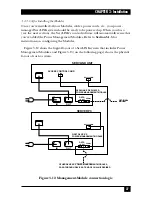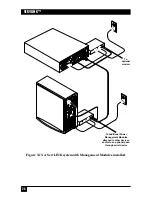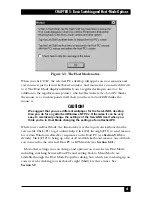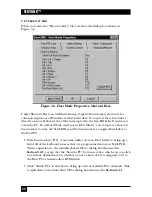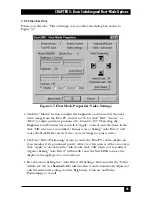
32
SERVLINK™
4. Configuration
4.1 Configuring the ServLINK to Switch Between Your PCs (KVM-Switched
Systems Only)
The ServLINK is designed to handle switching between the PCs in your system
through an on-screen menu (see
Section 6.1.1
). When you select a PC from the
menu, the ServLINK sends the appropriate keystroke commands to an attached
ServSwitch family KVM switch. However, different ServSwitch models recognize
different switching commands. For this reason, if you’ve connected your ServLINK
to a ServSwitch system, you might need to configure the ServLINK so that it can
perform switching properly.
If you’ve only connected a single PC to your ServLINK, the ServLINK won’t need
to do any switching, but you need to tell the ServLINK that. In
Section 4.1.2
, take
step 1, then skip ahead and take steps 9 through 16—refer to those steps for details
about what you need to enter.
4.1.1 T
HE
S
TANDARD
C
ONFIGURATION
The ServLINK comes preconfigured with a switching menu (and a corresponding
set of keystroke commands) that will work for a basic system. If your system meets
all
of the following requirements, you won’t need to configure the ServLINK’s
switching menu, so you can skip ahead to
Section 4.2
:
1. You have 14 or fewer PCs connected to the ServLINK.
2. All of the PCs are connected to the ServLINK through any version (original,
-R2, -R3, etc.) of one of these ServSwitch models: ServSelect™ (our product
codes KV104A or KV108A), ServSwitch Multi (KV150A or KV160A),
ServSwitch™ Multi MX (KV155A), or ServSwitch™ Multi Z8 (KV158A). Any
ServSwitch Multi must be assigned a chassis address from 0 to 10.
3. The system has only one user.
If your configuration varies from this one, follow the steps in
Section 4.1.2
to add
computers to your ServLINK system’s switching menu.
Summary of Contents for ServLink ACR3500A
Page 111: ...NOTES ...
Page 112: ...NOTES ...
Page 113: ...NOTES ...
Page 114: ...NOTES ...
Page 115: ...NOTES ...










